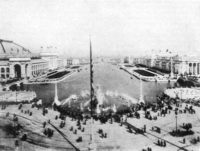Anthony Tung's Preserving the World's Great Cities would be a worthwhile read if the only brilliant observation it contained were Tung's simple explanation of the layout of the London Underground system. As a New Yorker who once lived, briefly, in London, I could never quite place what it was about the Tube that seemed so much more convenient than the more overtly rational New York City subway, where the major lines follow aboveground streets. "It was a practical planning conception of brilliance," Tung writes of the Underground, "creating an underlying structural skeleton to a city that otherwise defied attempts to give it a greater physical order.... The plan of the Underground was the plan of important urban locations, not the plan of important city streets." The London Underground defines London, in other words; the New York subway merely echoes the city above.
This particular observation, as brilliant and as obvious in retrospect as the city planning decision it illuminates, comes about three quarters of the way through Preserving the World's Great Cities, at which point the reader has already inhaled complete urban histories of Warsaw, Beijing, Moscow, Rome, Cairo, Athens, Singapore, Amsterdam and Vienna. For the most part, each city is given its own chapter, though cities that share themes (Beijing and Moscow were both reshaped by Communist governments, for instance) are occasionally covered together. And London, Paris, Venice, New York, Kyoto, Berlin, Jerusalem and Charleston, South Carolina are still to come. Tung's extraordinary accomplishment, outside of anything that has strictly to do with preservation, is to encapsulate so many urban histories in less than 500 pages. He could almost have published the book without the title's first word, and billed the thing as an urban studies textbook (which it will no doubt become anyway, though for its comprehensive survey of preservation history).
But that doesn't do the book justice either, since it is so well written. Tung doesn't write like an academic, though he obviously has the academic's grasp of his material. His economy of language allows the history of a city like Beijing—a history that stretches from Mao all the way back to Kublai Khan—to come across clearly in just a few pages. This is important, since for all its utility as an urban survey, Preserving the World's Great Cities is ultimately about preservation. Different cultures have found different ways to preserve their cities, and for different reasons. This book gets to the root of the laws that govern preservation; of the amazing will that led Varsovians to document the landmarks of their city as Hitler was threatening, and then to recreate them when he had been defeated; of the good and bad effects of Communism's ideological identification with certain types of architecture. Eight million stories in the naked city, you say? How about that multiplied by 18 cities?
Tung has a good take on the destructiveness of International Modernism, as well. He points out that Modernist architecture was rarely drawn in its historical context, but either unconnected to any context at all, or in an EPCOT Center-like world that is completely composed of Modern design. As Tung says, "the natural consequence of the wholesale reconception of architecture seemed to be the complete remaking of the built environment." This is another instance of Tung's ability to take a complicated idea and render it in simple prose that makes it seem as if it should have been abundantly clear to any intelligent human being. And yet, he never condescends. This is a book not just for academics or students or professional policy-makers, though all of them would be well advised to pick up a copy. No, this book is for any lover of cities or history. It is an epic, or rather, 18 little epics packed into one important book.





